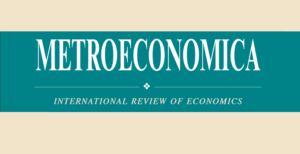Call for Papers
Metroeconomica
Special issue on ‘Luigi Pasinetti on capital: critical and constructive aspects’
Guest Editors:
Enrico Bellino (enrico.bellino@unicatt.it) and Ariel L. Wirkierman (a.wirkierman@gold.ac.uk)
Context and motivation:
Capital theory is one of the fields where Luigi Pasinetti provided outstanding and original
contributions. From his enlightening exposition of Joan Robinson’s ‘spectrum’ of techniques and the Wicksell effect (Pasinetti, 1958, 1978); to his sharp analysis of the impossibility of ordering the techniques of production monotonically according to their degree of mechanization, so that an increase of the rate of profit may bring about a reduction but also an increase in the value of capital per worker (Pasinetti, 1965, 1966), as well as the refutation of Robert Solow’s attempt to provide an expression of the marginal productivity of capital for the society as a whole (Pasinetti, 1969).
These contributions by Pasinetti, together with significant others by Pierangelo Garegnani, triggered a major criticism to neoclassical capital theory, and more generally, to the entire logical structure of marginalist theories. Many authoritative neoclassical economists took the blow: some of them admitted the problems, others tried to minimize them, whilst others tried to circumvent them by reformulating the general equilibrium model in such a way to overcome the problems addressed at the cost of introducing further assumptions that, at best, significantly reduced the explanatory power of the model.
Together with Joan Robinson, Piero Sraffa and Pierangelo Garegnani, Luigi Pasinetti can certainly be regarded as an originator of the strand of criticism to the internal logic of the marginalist/neoclassical approach. Alongside this, he also gave several positive contributions to capital theory, which were mainly conceived in view of the construction of his model of structural economic dynamics (Pasinetti, 1963, 1965, 1981, 1993). In particular, one of the first of these contributions, concerning the notion of vertical integration in multi-sectoral models of production, was published in Metroeconomica in 1973 (Pasinetti, 1973).
Aim and Topics:
This special issue of Metroeconomica aims to collect new contributions which can shed light on the complicated relationships between production relations, distributive variables and relative prices, following or inspired by the work of Luigi Pasinetti. In particular, we call for original contributions on the following themes:
1) Criticism to the notion of capital as a single magnitude adopted within various fields of
contemporary economic analysis;
2) Criticism to the notion of temporary and intertemporal equilibrium;
3) Reswitching of techniques, reverse capital deepening: empirical evidence, analytical
plausibility and economic consequences;
4) Sraffian treatment of produced means of production (fixed and circulating capital) with
applications.
Timeline and other details:
Deadline for abstract submissions to the guest editors: Sunday, 22-October-2023;
Notification of approval of the submission for the special issue: Sunday, 15-November-2023;
Submission of full papers to Metroeconomica: Sunday, 30-June-2024;
Note: submission to Metroeconomica is done through the website
https://editorialexpress.com/cgi-bin/e-editor/e-submit_v7.cgi?dbase=meca indicating in the field “notes”: “paper submitted to special issue ‘Luigi Pasinetti on capital: critical and constructive aspects’.
Scholars interested in submitting a full paper are invited to submit a manuscript proposal with a title and abstract of (approximately) 400 words by e-mail to Enrico Bellino (enrico.bellino@unicatt.it) and Ariel L. Wirkierman (a.wirkierman@gold.ac.uk).
The guest editors will select proposals on the basis of their fitting the aims and scope of the special issue. The managing editors of Metroeconomica will follow the usual refereeing process of Metroeconomica.
References:
Pasinetti, L.L. (1958) Il Recente Modello di Sviluppo di J. Robinson e la Teoria Neo-Classica del Capitale: Alcune Osservazioni, Rivista Internazionale di Scienze Sociali, Serie III, 29(5):429-444.
Pasinetti, L.L. (1963) A Multi-Sector Model of Economic Growth. King’s College, Cambridge.
Pasinetti, L. L. (1965) Changes in the Rate of Profit and “Degree of Mechanization”: A Controversial Issue in Capital Theory, Paper presented at the “Theory of Capital and Economic Growth” session of the First World Congress of the Econometric Society, Rome, Sep-1965.
Pasinetti, L.L. (1965) A New Theoretical Approach to the Problem of Economic Growth. In: The
Econometric Approach To Development Planning. Pontificia Academia Scientiarvm, Città del Vaticano.
Pasinetti, L. L. (1966) Changes in the Rate of Profit and Switches of Techniques, The Quarterly Journal of Economics, 80(4):503-517.
Pasinetti, L. L. (1969) Switches of Technique and the “Rate of Return” in Capital Theory, The Economic Journal, 79(315):508-531.
Pasinetti, L.L. (1973) The notion of vertical integration in economic analysis, Metroeconomica 25, 1–29.
Pasinetti, L. L. (1978) Wicksell Effects and Reswitchings of Technique in Capital Theory, The Scandinavian Journal of Economics, 80(2):181-189.
Pasinetti, L.L. (1981) Structural Change and Economic Growth: A Theoretical Essay on the Dynamics of the Wealth of Nations. Cambridge University Press, Cambridge.
Pasinetti, L.L. (1993) Structural Economic Dyanmics: A Theory of the Economic Consequences of Human Learning. Cambridge University Press, Cambridge.
